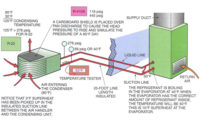I live in Central Florida, and while it can get pretty hot in the Summer we also tend to get afternoon thunderstorms that come and go in a flash. I have been connecting gauges, checking charges, and even pulling vacuums in the rain as well as under umbrellas or cardboard boxes most of my career and only recently did I stop to think if this was a good idea.
Moisture in the System
I am going to go ahead and make the blanket statement that opening the system or connecting gauges while it is actively raining is just a bad idea. Not because you are “made of sugar” like the old timers might claim, but rather because even a drop of water in the system can do a lot of damage in the age of polyolester (POE) oil. If you have a good shelter or large umbrella you might be okay, but in Florida we get these bursts of crazy weather that you probably aren’t going to keep out of an open suction line.
This isn’t to say you don’t start a compressor just because it looks like it “might rain”, but I would suggest being prepared with caps or plugs to seal it up quickly if it does start to pour.
If it is actively raining I would also advise against connecting gauges or opening the panels and testing electrical components unless you have a good umbrella or shelter in place. Electrical testing can damage the components as well as be unsafe, and connecting in the rain can lead to moisture contamination.
Wet Condenser Coil
You will not be able to test or set a charge with any level of accuracy when the condenser coil is wet. The system pressures will be low and the subcool will be high due to the evaporative effect and the superior heat transfer of water over air. If you want to simply confirm that the unit is functional you can take an evaporator delta T and measure the liquid line and suction line temps at the evaporator to approximate proper operation. You will not be able to “set the charge” until the condenser coil has been allowed to dry completely.
The liquid line will generally be around the outdoor temperature or maybe even a bit lower depending on the SEER of the unit and how wet the coil is (Wetter / Higher SEER = Cooler Liquid Line)
The suction line will be approximately the return temp minus 40°F(4.44°C) + the desired superheat +/- 5°F(2.75°K), It will tend to be on the lower side of the evaporator temperature scale because of the lower liquid pressure.
My Opinion
If you read our articles you know that we are huge advocates of taking accurate measurements and not just walking away from a system without doing appropriate testing. However, if it is raining you are just not going to get good readings and you also risk doing more harm than good to the system by taking them. Sometimes taking fewer readings can be the best call. When it’s raining I would rather have my techs note the delta T and indoor liquid line and suction line temps and note”raining” than to risk an issue by connecting in the rain.
In cases where the charge must be set, we will need to go back once it is dry to set it. In cases where we did a simple drain cleaning, replaced a blower wheel or thermostat or a capacitor those indoor readings will suffice. Are they conclusive? No! would I rather contaminate a system? Nope. Should we return to every system the next day just because it was drizzling to check the charge with gauges? I say no to this as well.
You may say (as many do) that connecting while raining has never caused issues for you before. To that I would say, How do you know?
It’s not like introducing moisture causes the compressor to instantly explode.
It was also less of an issue when mineral oil was the prevalent oil in use.
Am I saying that you can never check a charge even in a light sprinkle? No
Just use common sense, don’t be a robot that always connects gauges even when it will likely do more harm than good.
Publication date: 4/23/2018
Want more HVAC industry news and information? Join The NEWS on Facebook, Twitter, and LinkedIn today!









